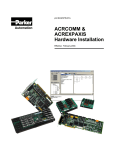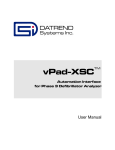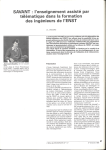Download ^1 USER MANUAL ^2 Accessory 24V
Transcript
^1 USER MANUAL ^2 Accessory 24V ^3 PMAC VME Axis Expansion Card ^4 3Ax-602226-xUxx ^5 October 15, 2003 Single Source Machine Control Power // Flexibility // Ease of Use 21314 Lassen Street Chatsworth, CA 91311 // Tel. (818) 998-2095 Fax. (818) 998-7807 // www.deltatau.com Copyright Information © 2003 Delta Tau Data Systems, Inc. All rights reserved. This document is furnished for the customers of Delta Tau Data Systems, Inc. Other uses are unauthorized without written permission of Delta Tau Data Systems, Inc. Information contained in this manual may be updated from time-to-time due to product improvements, etc., and may not conform in every respect to former issues. To report errors or inconsistencies, call or email: Delta Tau Data Systems, Inc. Technical Support Phone: (818) 717-5656 Fax: (818) 998-7807 Email: [email protected] Website: http://www.deltatau.com Operating Conditions All Delta Tau Data Systems, Inc. motion controller products, accessories, and amplifiers contain static sensitive components that can be damaged by incorrect handling. When installing or handling Delta Tau Data Systems, Inc. products, avoid contact with highly insulated materials. Only qualified personnel should be allowed to handle this equipment. In the case of industrial applications, we expect our products to be protected from hazardous or conductive materials and/or environments that could cause harm to the controller by damaging components or causing electrical shorts. When our products are used in an industrial environment, install them into an industrial electrical cabinet or industrial PC to protect them from excessive or corrosive moisture, abnormal ambient temperatures, and conductive materials. If Delta Tau Data Systems, Inc. products are directly exposed to hazardous or conductive materials and/or environments, we cannot guarantee their operation. Accessory 24V – PMAC VME Axis Expansion Card Table of Contents INTRODUCTION .......................................................................................................................................................1 ACC-24V Options.....................................................................................................................................................1 CONNECTORS ...........................................................................................................................................................3 P1..........................................................................................................................................................................3 J1 ..........................................................................................................................................................................3 J2 ..........................................................................................................................................................................3 J3 ..........................................................................................................................................................................3 J4 ..........................................................................................................................................................................3 J5 ..........................................................................................................................................................................3 J6 ..........................................................................................................................................................................3 J7 ..........................................................................................................................................................................3 J8 ..........................................................................................................................................................................3 J9 ..........................................................................................................................................................................3 P2A (JMACH4).....................................................................................................................................................3 P2 (JMACH3) .......................................................................................................................................................4 TB1 .......................................................................................................................................................................4 ACC-24V CONNECTIONS........................................................................................................................................5 Power Connection .....................................................................................................................................................5 Basic PMAC-VME Connection.............................................................................................................................5 Connection to ACC-14V .......................................................................................................................................5 Connection ACC-28..............................................................................................................................................5 Connection to ACC-8D (or ACC-8P) ....................................................................................................................5 DSPGATE CONSIDERATIONS ...............................................................................................................................7 Using ACC-24 Data ..................................................................................................................................................7 Flag Registers within ACC-24V DSPGATEs........................................................................................................8 CONNECTOR PINOUTS.........................................................................................................................................11 TB1* 4-Pin Terminal Block ................................................................................................................................11 J3 and J4 (36-Pin Header) ................................................................................................................................11 J6 (10-Pin Connector) ........................................................................................................................................12 J7 JEQU (10-Pin Connector) .............................................................................................................................12 J8 (JS3) (16-Pin Header)....................................................................................................................................13 J5 and J9 (JS4) (16-Pin Header) (Labeled J1 on OPT-1 board)........................................................................13 P2 JMACH3 (96-Pin Header) ............................................................................................................................14 P2A JMACH4 (96-Pin Header on Option 1) ......................................................................................................16 JUMPER/E-POINT DESCRIPTIONS ....................................................................................................................19 Table of Contents i Accessory 24V – PMAC VME Axis Expansion Card ii Table of Contents Accessory 24V – PMAC VME Axis Expansion Card INTRODUCTION PMAC’s Accessory 24, the Axis Expansion board, provides four or eight additional channels of quadrature encoder inputs, analog outputs, data lines for analog inputs, and motor related flags (Limits, Home Flags, Amp. Enables, Amp. Faults, and position Compare-Equal signals). This Accessory is intended for those applications which require more than the basic eight channels of the above signals provided on the PMAC base board (when used with its Option 1). In particular, PMAC’s dual feedback servo capability or its motor commutation feature for more than four position loops requires ACC-24. This is because, in the above applications, either two channels of encoder feedback signals, or two analog output channels are required for each motor. In applications which require some extra Master / Handwheel encoder inputs ACC-24 may also be required. ACC-24 comes in two forms: ACC-24P for PMAC-PC and ACC-24V for PMAC-VME. The STD BUS version of PMAC is not supported with this Accessory. This Manual deals with ACC-24V, WHICH is to be used in conjunction with PMAC-VME. For the PC bus version of this Accessory, a separate Manual is provided. ACC-24V Options ACC-24V fits in the next open bus slot and communicates to PMAC-VME via a provided 50-pin flat cable. The basic form of this Accessory contains one PMAC DSPGATE. It, therefore, can support 4 extra channels of encoder inputs and analog outputs. ACC-24V OPT-1 provides another DSPGATE, which extends its capabilities to 8 channels. This Option comes as piggyback board for the main ACC24V card. It communicates to ACC-24V via the connector p3 located on the main card. Introduction 1 Accessory 24V – PMAC VME Axis Expansion Card 2 Introduction Accessory 24V – PMAC VME Axis Expansion Card CONNECTORS Refer to the schematic layout diagram of ACC-24V for connector locations on the board. Also refer to the pin definition listings at the end of this Manual. P1 This connector provides structural support as well as the digital power supply (+5V) for ACC-24V. It can also bring in the +12V and the -12V supplies from the bus provided jumpers E85, E87, and E88 are installed (the installation of these jumpers voids the opto-isolation feature of ACC-24V) J1 This connector provides the link between ACC-24V and PMAC-VME via the J2 (JEXP) connector on the CPU board. A 50-pin flat cable is provided for this task (see also the connection diagram). J1 must be connected to the PMAC CPU board's J2 (JEXP). J2 This connector provides the signals provided on the J1 connector in a buffered form. If one ACC-14V (the I/O expansion board) is used in conjunction with a PMAC-VME and an ACC-24V, then this connector should be used for the connection to the ACC-14V's J10 connector. For more than one ACC14V, a daisychain connector is needed. (See the relevant connection diagram). J3 This is an iSBX connector, which provides only +5V, GND, +12V, and -12V power supplies for an iSBX module such as ACC-28 (analog-to-digital converter board). J4 This is another iSBX connector with identical pin description as J3. J5 This connector contains miscellaneous I/O signals related to the second DSPGATE on ACC-24V OPT. 1. It is typically used for direct connection to ACC-28 (the analog-to-digital converter board). J6 This connector brings in the required DSPGATE clock signals from PMAC’s J6 (JXIO) connector. A 4pin flat cable is provided for this purpose. For proper operation of ACC-24V J6 must be connected to PMAC's J6 (JXIO). J7 This connector brings out the eight Compare-Equal signals generated from the DSPGATES on ACC-24V and its OPT-1. Jumpers E93 and E94 determine the signals' polarities. J8 This connector contains miscellaneous I/O signals related to the first DSPGATE on ACC-24V. It is typically used for direct connection to ACC-28 (the analog-to-digital converter board). J9 This connector’s pins are hardwired (pin-to-pin) to the connector J5. P2A (JMACH4) This connector contains the signals for motor/encoder channels 13 to 16. Typically, this connector is linked to ACC-8D, the Terminal Block board, via a 64-pin flat cable supplied with ACC-8D Option V. This connector is on ACC-24V Opt. 1, the piggyback board. Connectors 3 Accessory 24V – PMAC VME Axis Expansion Card P2 (JMACH3) This connector contains the signals for motor/encoder channels 9 to 12. Typically, this connector is linked to ACC-8D, the Terminal Block board, via a 64-pin flat cable supplied with ACC-8D Option V. TB1 This is a 4-pin terminal block, which provides an alternative digital power supply (+5V) input to ACC24V. It is typically used for applications, which require this Accessory’s operation outside a VME rack. In addition, TB1 can also bring in +12V and -12V power supply inputs. For this purpose, jumpers E85, E87, and E88 must be installed. Note that this configuration voids the opto isolation feature of the board. 4 Connectors Accessory 24V – PMAC VME Axis Expansion Card ACC-24V CONNECTIONS In order to use ACC-24V in conjunction with PMAC-VME and other related Accessories several connections are required. In this section, the most critical connections are explained (Also, see the connection diagrams within this Manual). Power Connection ACC-24V is designed to fit into VME slot, but it only uses the bus for structural support and power supply. When inserted into the bus, ACC-24V always uses the +5V bus power supply for its digital circuitry. It can also pass this supply to encoders through its JMACH connector(s). Outside a VME rack, the terminal block tb1 may be used for ACC-24V's digital (circuitry) power supply. We recommend that the power for the board's analog circuitry come from a separate supply through the JMACH connector(s). This is especially helpful if large motors are being controlled. However, it is possible to bring in the +12V and -12V from the bus (or through the terminal block) for the purpose of powering the analog circuitry on ACC-24V. In this case, jumpers E85, E87, and E88 should be installed (this configuration defeats the opto isolation feature of the board). Basic PMAC-VME Connection A 4" long (supplied) 50-pin flat cable should be used to connect PMAC's JEXP (J2 on the CPU board) to ACC-24V's J1. In addition, a (supplied) 4-pin flat cable should be used between PMAC's JXIO (J6 on PMAC's main board) and ACC-24V's J6. Connection to ACC-14V If one ACC-14V (the I/O expansion board) is used in conjunction with a PMAC-VME and an ACC-24V, then the connector J2 should be used for the connection to the ACC-14V’s J10 connector. For more than one ACC-14V, a daisy chain connector is needed. (See the connection diagram.) Connection ACC-28 Up to two ACC-28s may be connected via J8 and J9 to one ACC-24V. The first ACC-28's J1 connects to J8; the second ACC-28's J1 connects to J9 (note that the second connection is only possible when Opt.1 is installed). If ACC-28s have the mating iSBX connectors, they may be directly plugged into ACC-24V's connectors J3 and J4 for structural support. Connection to ACC-8D (or ACC-8P) Each JMACH connector (J7 and J8) may be connected to one Terminal Block board (ACC-8D). The Terminal Blocks should be ordered with Option V so that the 64-pin socket and flat cable are provided for the connection to ACC-2V. 24-V Connections 5 Accessory 24V – PMAC VME Axis Expansion Card 6 24-V Connections Accessory 24V – PMAC VME Axis Expansion Card DSPGATE CONSIDERATIONS The maximum number of DSPGATEs used with each PMAC is four. The DSPGATES are used for PMAC's specific motor/ amplifier/ encoder interface functions. Each DSPGATE handles these functions for four channels. Thus, the basic FOUR axes PMAC talks to one on-board DSPGATE. A PMAC with Option 1 talks to two on-board DSPGATEs, which provides these functions for eight channels. A PMAC with Option 1 and an ACC-24V will talk to three DSPGATES. A PMAC with Option 1, connected to an ACC-24V with its Opt.1, talks to four DSPGATEs. As a result, whenever an ACC-24V is used, other Accessories with on-board DSPGATEs should not be used. Otherwise, PMAC 's channels 9 to 16 will not function properly. Currently, for PMAC-VME, the only Accessory with this conflict is the Accessory 29, the MDLT transducer interface board. Using ACC-24 Data PMAC's Main Manual provides the details of the memory map for ACC-24V’s DSPGATEs (this will not be repeated here). These DSPGATE registers may be directly or indirectly read, written to, or inspected via some specific I-variables, M-variables, and the on-line read/write commands. M-variables may be used to directly access these registers within the user programs. Alternatively, it is possible to use PMAC's "on-line" Memory Read and Memory Write commands (R, RH, and W) to access these registers. In this section, the pertinent I-variables, which should be set in order to use the DSPGATEs within ACC24V, will be mentioned. This will be followed by a brief note on the use of M-variables for reading and writing to various DSPGATE registers. Refer to the PMAC Main Manual for more details of I-variables and M-variables definitions and assignments. I-Variable Assignment The key I-variables which may require assignment (or re-assignment) are Ix02, Ix03, Ix04, Ix05, Ix25, and Ix83. Ix02 tells PMAC where (what address) to put the output command for motor x. If a DAC register within ACC-24V’s DSPGATEs is to be used for command output, then this parameter should be modified. Example: To use the first DAC on the third DSPGATE (first DSPGATE on ACC-24V) for motor 5, I502= $C023. For PMAC commutated motors, Ix02 must point to the lower address of a pair of adjacent DACs that are being used to command the phases of the motor (DACs 9 and 10, or 11 and 12, or 13 and 14, or 15 and 16 on ACC-24V and its Opt. 1). Ix03 through Ix05 tell PMAC where to look for position feedback / master handwheel information via the Encoder Conversion Table. This table should be extended using PMAC’s memory write (WY) command, or through a special window in the PMAC executive program, to include the appropriate registers within ACC-24V's DSPGATES. Instead of the memory, write command the special window in the PMAC’s Executive software may also be used. In addition, Ix03 through Ix05 should be modified accordingly to addresses of theses new conversion table entries. For example, to extend the default version of PMAC’s Encoder conversion table by one entry, we may use WY:$72A,$00C020,$00 (see the section on "Encoder Conversion Table in the PMAC’s Main Manual). Here, $C020 is the address of the first encoder counter on ACC-24V (ENC. 9). This address is written in the last entry within the default conversion table at $72A. In addition, Ix03 is modified to be: Ix03= $72A. DSPGATE Considerations 7 Accessory 24V – PMAC VME Axis Expansion Card Note For Dual Feedback application Ix03 and Ix04 will have to be assigned to different addresses within the table. The instruction for setting Ix05, Motor x Master (handwheel) position address is identical to those for Ix03, except that extended bits (bits 16 to 23) of the data mean different things (see the I-variable Specification section within the PMAC's Main Manual). Ix25 parameter tells PMAC what set of input it will look to for motor x’s limit switches, home flag, and Amplifier Fault flag. Typically, these are the inputs associated with an encoder input, specifically, those of the position feedback encoder for the motor. The default values of Ix25s point to addresses within the first two DSPGATEs on board the PMAC main board. To re-assign a particular Ix25 to an appropriate address within the DSPGATEs on board ACC-24V the following table should be used: Flag Registers within ACC-24V DSPGATEs lim9, hmfl9, ... lim10, hmfl10, ... lim11, hmfl11, ... lim12, hmfl12, ... lim13, hmfl13, ... lim14, hmfl14, ... lim15, hmfl15, ... lim16, hmfl16, ... $C020 $C024 $C028 $C02C $C030 $C034 $C038 $C03C Ix83 is the parameter, which tells PMAC which register to get its commutation (phasing) information from for motor x on an ongoing basis. This parameter which applies only to PMAC commutated motors, has default values pointing to the "phase position" encoder registers within the DSPGATEs. The default addresses for motors 1 to 4 are on the PMAC’s DSPGATEs; for motors 5 to 8, they are on ACC-24V's DSPGATEs (see the PMAC Main Manual I-variable Specification section). If the default values are not appropriate for a particular application, they may be easily modified using I-variable assignment statements. M-Variable Assignment A detailed description of M-variable assignment and use to access PMAC's memory and I/O space is given in the PMAC's Main Manual (under PMAC Computation Features). The user may assign Mvariables to any of the registers within the DSPGATEs (see the section on “PMAC DSP-GATE Features” in the Main Manual). These registers may be subsequently read or written to using these (previously defined) M-variables. Example: To read ADC register 16 (on the second DSPGATE within ACC-24V), the definition: M216->Y:$C03F,8,16,S (ADC16: 8-bit offset,16-bits wide) assigns M variable 216 to ADC16. Subsequently, M216 may be used within a user program. For example: X(M216*3) (Move x-axis proportional the value of ADC16. ) However, care should be taken to distinguish between the input and the output registers within each DSPGATE (see the Memory Map Section in the PMAC's Main Manual). In addition, it should be noted that most of these registers are updated (written into) by PMAC when latching external devices during servo loop closure interrupts (e.g. ADC registers, Servo Position (encoder) registers, etc.). Others, such as the DAC registers, are updated automatically by PMAC's firmware during the servo loop (or phasing) interrupts. 8 DSPGATE Considerations E90 E87 E17D E17B E17A E17C DSPGATE Considerations E27 E26 E25 E85 E96 E97 E89 E95 1 TB1 4 P3 J6 J7 P1 9.25 in (234.95mm) P2 E99 E88 J8 E24 J9 E93 J5 E94 J4 J3 ACCESSORY-24V J1 J2 Accessory 24V – PMAC VME Axis Expansion Card 9 6.25 in (158.75mm) 4-pin flat cable (supplied w/ ACC-24V) PMAC-VME P1 J8 BU FFER J10 ACC-24V P2 J6 P1 J1 J2 50-pin flat cable (supplied w/ ACC-24V) JMACH 1 J6 CPU VME BUS J2-JEXP Connecting PMAC-VME to ACC-24V and one ACC-14V P2 (96 PIN) (JMACH1 or JMACH2) P1 (96 PIN) Accessory 24V – PMAC VME Axis Expansion Card To 2nd ACC-14v J10 connector 1st ACC-14V 10 DSPGATE Considerations Accessory 24V – PMAC VME Axis Expansion Card CONNECTOR PINOUTS TB1* 4-Pin Terminal Block Top View Pin # Symbol Function Description 1 GRD Input Digital Ground 2 + 5V Input +5V Supply 3 +12V Input +12V Supply 4 -12V Input -12V Supply *TBI may be used as an alternative power supply connection if ACC-24V is not used with a VME rack. Note: for +12V and -12V input through TB1 jumpers E85, E87, and E88 must be installed. This does, however, defeat the opto-isolation feature of the board. J3 and J4 (36-Pin Header) Pin # Symbol Function Description 1 +12V Output Positive Analog Supply 2 -12V Output Negative Analog Supply 3 GND Common Ground 4 +5V Output Digital Supply 5-23 NC 24 25 NC 26 NC 27 NC 28 29 NC 30 NC 31 NC 32 33 NC 34 NC 35 GND Common Ground 36 +5V Output Digital Supply Typically, J3 and J4 are iSBX connectors which are used for ACC-28's (analog-to-digital converter boards) power supply. Connector Pinouts 11 Accessory 24V – PMAC VME Axis Expansion Card J6 (10-Pin Connector) Top View Pin # Symbol Function Description 1 2 3 4 5 6 7 8 9 10 NC NC NC NC NC NC NC NC SCLK DCLK Output Output System Clock Servo-Encoder Clock D to A, A to D Clock Notes Servo-Encoder Timing Clock DAC and ADC Clock for Channels 9 to 16 This connector brings in SCLK and DCLK signals from PMAC-VME. This connector must be connected to J6 of PMAC-VME’s J6 connector via the 4-pin flat cable supplied with ACC-24V. J7 JEQU (10-Pin Connector) Pin # Symbol Function Top View Description Notes 1 EQU 9/ Output Enc. 9 Comp-Eq Low True 2 EQU10/ Output Enc. 10 Comp-Eq Low True 3 EQU11/ Output Enc. 11 Comp-Eq Low True 4 EQU12 Output Enc. 12 Comp-Eq Low True 5 EQU13/ Output Enc. 13 Comp-Eq Low True 6 EQU14/ Output Enc. 14 Comp-Eq Low True 7 EQU15/ Output Enc. 15 Comp-Eq Low True 8 EQU16/ Output Enc. 16 Comp-Eq Low True 9 +V Supply Positive Supply Low True 10 GND Common Ground +5 to +24V This connector brings out the eight Compare-Equal signals generated from the DSPGATES on ACC-24V and its OPT 1. Refer to Jumpers E93 and E94 for proper configuration of this output (for sourcing or sinking type outputs). 12 Connector Pinouts Accessory 24V – PMAC VME Axis Expansion Card J8 (JS3) (16-Pin Header) Top View Pin # Symbol Function Description Notes 1 DCLK Output D to A, A to D Clock DAC and ADC Clock for Ch. 9, 10, 11, 12 2 BDATA3 Output D to A Data DAC Data for Ch. 9, 10, 11, 12 3 ASEL4/ Output Axis Select Bit 0 Select for Ch. 9, 10, 11, 12 4 ASEL5/ Output Axis Select Bit 2 Select for Ch. 9, 10, 11, 12 5 CONVERT 45 Output A to D Convert ADC Convert Signal Ch. 9, 10, 11, 12 6 ADCIN3 Input A to D Data ADC Data for Ch. 9, 10, 11, 12 7 OUT 9/ Output Amp Enable /Dir. Amp Enable/Direction for Ch. 9 8 OUT 10/ Output Amp Enable /Dir. Amp Enable/Direction for Ch. 10 9 OUT11/ Output Amp Enable /Dir. Amp Enable/Direction for Ch. 11 10 OUT12/ Output Amp Enable /Dir. Amp Enable/Direction for Ch. 12 11 HF 9 Input Amp Fault AMP Fault Input for Ch. 9 12 HF 410 Input Amp Fault AMP Fault Input for Ch. 10 13 HF 411 Input Amp Fault AMP Fault Input for Ch. 11 14 HG 412 Input Amp Fault AMP Fault Input for Ch. 12 15 +5V Output +5V Supply Power Supply Out 16 GND Common PMAC Common Typically, miscellaneous I/O is used to interface with ACC-28 (the analog-to-digital converter board). J5 and J9 (JS4) (16-Pin Header) (Labeled J1 on OPT-1 board) Pin # Symbol Function Top View Description Notes 1 DCLK Output D to A, A to D Clock DAC and ADC Clock for Ch. 13, 14, 15, 16 2 BDATA4 Output D to A Data DAC Data for Ch. 13, 14, 15, 16 3 ASEL6/ Output Axis Select Bit 0 Select for Ch. 13, 14, 15, 16 4 ASEL7/ Output Axis Select Bit 2 Select for Ch. 13, 14, 15, 15 5 CONVERT 67 Output A to D Convert ADC Convert Signal Ch. 13, 14, 15, 16 6 ADCIN4 Input A to D Data ADC Data for Ch. 13, 14, 15, 16 7 OUT 13/ Output Amp Enable /Dir Amp Enable/Direction for Ch. 13 8 OUT 14/ Output Amp Enable /Dir Amp Enable/Direction for Ch. 14 9 OUT15/ Output Amp Enable /Dir Amp Enable/Direction for Ch. 15 10 OUT16/ Output Amp Enable /Dir Amp Enable/Direction for Ch. 16 11 HF 413 Input Amp Fault Amp Fault Input for Ch. 13 12 HF 414 Input Amp Fault Amp Fault Input for Ch. 14 13 HF 415 Input Amp Fault Amp Fault Input for Ch. 15 14 HG 416 Input Amp Fault Amp Fault Input for Ch. 16 15 +5V Output +5V Supply Power Supply Out 16 GND Common PMAC Common Typically, miscellaneous I/O is used to interface with ACC-28 (the analog-to-digital converter board). Connector Pinouts 13 Accessory 24V – PMAC VME Axis Expansion Card P2 JMACH3 (96-Pin Header) Pin # Symbol Function Description A01 A02 A03 A04 A05 A06 A07 A08 A09 A10 A11 A12 A13 A14 A15 A16 A17 +5V GND CHC12 CHC12/ CHB12 CHB12/ CHA12 CHA12/ CHC10 CHC10/ CHB10 CHB10/ CHA10 CHA10/ DAC12 DAC12 AENA 12/DIR12 FAULT12 +LIM12 ** -LIM12 ** HMFL12 DAC10 DAC10/ AENA10/DIR10 FAULT10 +LIM10 ** -LIM10 ** HMFL10 Output* Common Input Input Input Input Input Input Input Input Input Input Input Input Output Output Output +5V Power PMAC Common Encoder C Ch. Positive Encoder C Ch. Negative Encoder B Ch. Positive Encoder B Ch. Negative Encoder A Ch. Positive Encoder A Ch. Negative Encoder C Ch. Positive Encoder C Ch. Negative Encoder B Ch. Positive Encoder B Ch. Negative Encoder A Ch. Positive Encoder A Ch. Negative Ana. Out Positive 12 Ana. Out Negative 12 Amp-Ena/Dir.12 A18 A19 A20 A21 A22 A23 A24 A25 A26 A27 A28 Input Input Input Input Output Output Output Input Input Input Input Amp-Fault 12 Positive Limit 12 Negative Limit 12 Home-Flag 12 Ana. Out Positive 10 Ana. Out Negative 10 Amp-Enable/Dir. 10 Amp-Fault 10 Positive Limit 10 Negative Limit 10 Home-Flag 10 Notes For Encoders Axis #12 Axis #12 Do not gnd if not used Axis #12 Axis #12 Do not gnd if not used Axis #12 Axis #12 Do not gnd if not used Axis #10 Axis #10 Do not gnd if not used Axis #10 Axis #10 Do not gnd if not used Axis #10 Axis #10 Do not gnd if not used +/-10V to agnd +/-10V to agnd Jumperable Polarity High True Failsafe High True Failsafe Programmable Polarity +/-10V to agnd +/-10V to agnd Jumperable Polarity High True Failsafe High True Failsafe High True Programmable Polarity Analog Common Analog Common Analog -15V Supply A29 AGND Input A30 A-15V Input A31 GND Common PMAC Common A32 +5V Output* +5V Power For Encoders Note: In stand-alone applications, these can be used as +5V power supply inputs to power PMAC's digital circuitry. 14 Connector Pinouts Accessory 24V – PMAC VME Axis Expansion Card P2 JMACH3 (96-Pin Header) Continued Pin # Symbol Function Description Notes CO1 +5V Output* +5V Power For Encoders CO2 GND Common PMAC Common CO3 CHC11 Input Encoder C Ch. Positive Axis #11 CO4 CHC11/ Input Encoder C Ch. Negative Axis #11 Do not gnd if not used CO5 CHB11 Input Encoder B Ch. Positive Axis #11 CO6 CHB11/ Input Encoder B Ch. Negative Axis #11 Do not gnd if not used CO7 CHA11 Input Encoder A Ch. Positive Axis #11 CO8 CHA11/ Input Encoder A Ch. Negative Axis #11 Do not gnd if not used CO9 CHC9 Input Encoder C Ch. Positive Axis #9 C10 CHC 9/ Input Encoder C Ch. Negative Axis # 9 Do not gnd if not used C11 CHB 9 Input Encoder B Ch. Positive Axis #9 C12 CHB9/ Input Encoder B Ch. Negative Axis #9 Do not gnd if not used C13 CHA9 Input Encoder A Ch. Positive Axis #9 C14 CHA9/ Input Encoder A Ch. Negative Axis #9 Do not gnd if not used C15 DAC11 Output Ana. Out Positive 11 +/-10V to AGND C16 DAC11 Output Ana. Out Negative 11 +/-10V to AGND C17 AENA 11/DIR11 Output Amp-Enable/Dir. 11 Jumperable Polarity C18 FAULT11 Input Amp-Fault 11 High True C19 +LIM11 ** Output Positive Limit 11 Failsafe High True C20 -LIM11 ** Input Negative Limit 11 Failsafe C21 HMFL11 Input Home-Flag 11 Programmable Polarity C22 DAC9 Output Ana. Out Positive 9 +/-10V to agnd C23 DAC9 / Output Ana. Out Negative 9 +/-10V to agnd C24 AENA9 /DIR9 Output Amp-Enable/Dir. 9 Jumperable Polarity C25 FAULT9 Input Amp-Fault 9 High True C26 +LIM9 ** Input Positive Limit 9 Failsafe High True C27 -LIM9 ** Input Negative Limit 9 Failsafe High True C28 HMFL9 Input Home-Flag 9 Programmable Polarity C29 ORST/ Output Following Error Out C30 A+15V Input Analog +15V Supply C31 GND Common PMAC Common C32 +5V Output* +5V Power For Encoders The P2 connector is use to connect ACC-24V to the third 4 channels (Channels 9, 10, 11, and 12) of servo amps and motors. ** Note: Pins marked -LIMn should be connected to switches at the positive end of travel; pins marked +LIMn should be connected to switches at the negative end of travel. Connector Pinouts 15 Accessory 24V – PMAC VME Axis Expansion Card P2A JMACH4 (96-Pin Header on Option 1) 16 Pin # Symbol Function Description A01 A02 A03 A04 A05 A06 A07 A08 A09 A10 A11 A12 A13 A14 A15 A16 A17 Output* Common Input Input Input Input Input Input Input Input Input Input Input Input Output Output Output +5V Power PMAC Common Encoder C Ch. Positive Encoder C Ch. Negative Encoder B Ch. Positive Encoder B Ch. Negative Encoder A Ch. Positive Encoder A Ch. Negative Encoder C Ch. Positive Encoder C Ch. Negative Encoder B Ch. Positive Encoder B Ch. Negative Encoder A Ch. Positive Encoder A Ch. Negative Ana. Out Positive 16 Ana. Out Negative 16 Amp-Ena/Dir.16 A18 A19 A20 A21 A22 A23 A24 A25 A26 A27 A28 +5V GND CHC16 CHC16/ CHB16 CHB16/ CHA16 CHA16/ CHC14 CHC14/ CHB14 CHB14/ CHA14 CHA14/ DAC16 DAC16 AENA 16/DIR16 FAULT16 +LIM16 ** - LIM16 ** HMFL16 DAC14 DAC14/ AENA14/DIR14 FAULT14 +LIM14 ** -LIM14 ** HMFL14 A29 A30 A31 A32 AGND A-15V GND +5V Input Input Common Output* Input Input Input Input Output Output Output Input Input Input Input Amp-Fault 16 Positive Limit 16 Negative Limit 16 Home-Flag 16 Ana. Out Positive 14 Ana. Out Negative 14 Amp-Enable/Dir. 14 Amp-Fault 14 Positive Limit 14 Negative Limit 14 Home-Flag 14 PMAC Common +5V Power Notes For encoders Axis #16 Axis #16 Do not gnd if not used Axis #16 Axis #16 Do not gnd if not used Axis #16 Axis #16 Do not gnd if not used Axis #14 Axis #14 Do not gnd if not used Axis #14 Axis #14 Do not gnd if not used Axis #14 Axis #14 Do not gnd if not used +/-10V to AGND +/-10V to AGND Jumperable Polarity High True Failsafe High True Failsafe Programmable Polarity +/-10V to AGND +/-10V to AGND Jumperable Polarity High True Failsafe High True Failsafe High True Programmable Polarity Ana. Common Analog Common Analog -15V Supply For Encoders Connector Pinouts Accessory 24V – PMAC VME Axis Expansion Card P2A JMACH4 (96-Pin Header on Option 1) Continued Pin # Symbol Function Description Notes CO1 CO2 CO3 CO4 CO5 CO6 CO7 CO8 CO9 C10 C11 C12 C13 C14 C15 C16 C17 +5V Output* +5V Power FOR ENCODERS GND Common PMAC Common CHC15 Input Encoder C Ch. Positive Axis #15 CHC15/ Input Encoder C Ch. Negative Axis #15 Do not gnd if not used CHB15 Input Encoder B Ch. Positive Axis #15 CHB15/ Input Encoder B Ch. Negative Axis #15 Do not gnd if not used CHA15 Input Encoder A Ch. Positive Axis #15 CHA15/ Input Encoder A Ch. Negative Axis #15 Do not gnd if not used CHC13 Input Encoder C Ch. Positive Axis #13 CHC 13/ Input Encoder C Ch. Negative Axis # 13 Do not gnd if not used CHB 13 Input Encoder B Ch. Positive Axis #13 CHB13/ Input Encoder B Ch. Negative Axis #9 Do not gnd if not used CHA13 Input Encoder A Ch. Positive Axis #913 CHA13/ Input Encoder A Ch. Negative Axis #13 Do not gnd if not used DAC15 Output Ana. Out Positive 15 +/-10V to agnd DAC15 Output Ana. Out Negative 15 +/-10V to agnd AENA Output Amp-Ena/Dir.15 Jumperable Polarity 15/DIR15 C18 FAULT15 Input Amp-Fault 15 High True C19 +LIM15 ** Input Positive Limit 15 Failsafe High True C20 -LIM15 ** Input Negative Limit 15 Failsafe C21 HMFL15 Input Home-Flag 15 Programmable Polarity C22 DAC13 Output Ana. Out Positive 13 +/-10V to agnd C23 DAC13/ Output Ana. Out Negative 13 +/-10V to agnd C24 AENA13 Output Amp-Ena/Dir.13 Jumperable Polarity /DIR13 C25 FAULT13 Input Amp-Fault 13 High True C26 +LIM13 ** Input Positive Limit 13 Failsafe High True C27 -LIM13 ** Input Negative Limit 13 Failsafe High True C28 HMFL13 Input Home-Flag 13 Programmable Polarity C29 ORST/ Output Following Err. Out C30 A+15V Input Analog +15V Supply C31 GND Common PMAC Common C32 +5V Output* +5V Power For Encoders The P2A connector is used to connect ACC-24V to fourth 4 channels (Channels 13, 14, 15 and 16) of servo amp and motors. ** Note: Pins marked -LIMn should be connected to switches at the positive end of travel; pins marked +LIMn should be connected to switches at the negative end of travel. Connector Pinouts 17 Accessory 24V – PMAC VME Axis Expansion Card 18 Connector Pinouts Accessory 24V – PMAC VME Axis Expansion Card JUMPER/E-POINT DESCRIPTIONS EPoint E17A} E17B} E17C} E17D} Physical Layout Description AENA (1-4 respectively) JUMP 1-2 for High True Remove jumper for low true AENA (1-4 respectively) Default No jumper installed [E24 - E27: Encoder single-ended/differential control] E24 E25 E26 E27 Jump pin 2 to 3 to obtain differential encoder input mode; Jump pin 1 to 2 to obtain non-differential encoder input mode; This will bias encoder negative inputs to 1/2 Vcc = 2.5V 1-2 Jumper installed (Non-Diff.) [E85: Host supplied analog power source enable] E85 Jump pin 1 to pin 2 to allow A +14V to come from P1 (Ties amplifier and ACC-24V power supply together Defeats opto coupling). Note that if E85 is changed, E88 and E87 must also be changed; also see E90. No jumper installed [E87 - E88: Host supplied analog power source enable] E87 E88 Jump pin 1 to pin 2 to allow analog gnd to come from P1 (Ties amplifier and ACC-24V gnd together. Defeats opto isolation). Note that if E87 is changed, E85 and E88 must also be changed; also see E90. Jump pin 1 to pin 2 to allow A-14V to come from P1 (ties amplifier and ACC-24V power supply together. Defeats opto isolation). Note that if E88 is changed, E87 and E85 must also be changed; also see E90. No jumper installed No jumper installed [E89: Amplifier-supplied switch pull-up enable] E89 Jump pin 1 to pin 2 to supply optically isolated flags from A+15V input “A+15V" on P2 (JMACH3) pin C30. E90 must have jump pins 1 to 2. Jump pins 2 to 3 to supply optically isolated flags from A+V input on the piggyback board (P2A pin C30). E90 must have jump pins 1 to 2. 1 to 2 jumper installed [E 90: Host-Supplied switch pull-up enable] E90 Jump pin 1 to pin 2 to allow A=15V/OPT=V” on P2A (JMACH4) pin C30, (also installed see E89) to power "Opto" switch sensor inputs (including limits). Jump pin 2 to 3 to allow "+12V" from bus connector to power "Opto" switch sensor inputs (including limits). Optical isolation is then lost. See also E85, E87, E88 and PMAC Opto Isolation Diagram. Jumper/E-Point Descriptions 1 to 2 jumper installed 19 Accessory 24V – PMAC VME Axis Expansion Card EPhysical Description Point Layout [E93 - E95: Compare-Equal output voltage configure] E93 E94 E95 Jump pin 1 to pin 2 to apply +V (+5V to 24V) to pin 11 of "U28" (should be ULN2803A for sink output configuration). Jump pin 2 to 3 to apply gnd to pin 11 of "U28" (S/B UDN2981A for source output configuration). Jump pin 1 to 2 to apply gnd to pin 10 of "U28" (S/B ULN2803A for sink output configuration). Jump pin 2 to 3 to apply +V (+5V to 24V) to pin 10 of "U28" (S/B UDN2981A for source output configuration). For future use. Default 1 to 2 jumper installed 1 to 2 jumper installed No jumper installed [E96-E97: Analog source isolate from Option 1] E96 E97 Jump 1-2 to connect A+15V on ACC-24V to A+15V on Option 1 piggyback board. Remove 1-2 to keep A+15V isolated between Option 1 board and main board. Jump 1-2 to connect A-15V on ACC-24V board to A15V on Option 1 piggyback board. Remove 1-2 to keep A-15V isolated between Option 1. Jumper installed Jumper installed [E99: Analog source isolate from Option 1] E99 Jump 1-2 to connect agnd on main ACC-24V to agnd on Option 1 piggyback board. Remove 1-2 to keep agnd isolated between Option 1 board and main board. Jumper installed [E17E - E17H: Amplifier - Enable polarity control] E17E} E17F} E17G} E17H} AENA (13-16 respectively) Jump 1-2 for high true. Remove jumper for low true AENA (13-16 respectively) No jumper installed [E18 - E21: Encoder single-ended/differential control] E18 E19 E20 Jump pin 2 to 3 to obtain differential encoder input mode; Jump pin 1 to 2 to obtain non-differential encoder input mode; this will bias encoder negative inputs to 1/2Vcc=2.5V. 1-2 Jumper Installed (Non-diff.) [E185, E187, E188: Host-supplied analog power source enable] E185 20 Jump pin 1 to pin 2 to allow A+14V to come from P1 (ties amplifier and PMAC-PC power supply together; defeats opto isolation). Note that if E185 is changed, E188 and E187 must also be changed; also see E190. No jumper installed Jumper/E-Point Descriptions Accessory 24V – PMAC VME Axis Expansion Card EPoint E187 E188 Physical Layout Description Jump pin 1 to pin 2 to allow analog gnd to come from P1 (ties amplifier and PMAC-PC gnd together. Defeats opto isolation). Note that if E187 is changed, E185 and E188 must also be changed; also see E190. Jump pin 1 to pin 2 to allow A-14V to come from P1 (ties amplifier and ACC-24V power supply together defeats opto (coupling). Note that if E188 is changed, E187 and E185 must also be changed. Also see E190. Default No jumper installed No jumper installed [E189: Amplifier-supplied switch pull-up enable] E189 Jump pin 1 to 2 to allow "A+15V/+V" on P2A (JMACH4) pin 59, to tie to "A+15V" on P2 (JMACH3) pin C30. This jumper must be installed to allow "A+15V" to power the "Opto" switch sensor inputs (including limits) from the same opto-power supply that powers the amplifier output stage. Also see E190. 1 to 2 jumper installed [E190: Host-supplied switch pull-up enable] E190 Jump pin 1 to 2 to allow "A+15V/OPT+V" on P2A (JMACH3) pin C30, (also see E189) to power "Opto" switch sensor inputs (including limits). Jump pin 2 to 3 to allow "+12V" from bus connector to power "Opto" switch sensor inputs (including limits). Optical isolation is then lost. See also E185, E187, E188 and figure on PMAC opto isolation. 1 to 2 jumper installed [E196-E197, E199: Analog source isolate from main board] E196 E197 E199 Jump 1-2 to connect A+15V on option 1 piggyback board to main ACC-24V board Remove 1-2 to keep A+15V isolated between main board and piggyback board Jump 1-2 to connect A-15V on Option 1 piggyback board to main ACC-24V board Remove 1-2 to keep A15V isolated between main board and piggyback board. No jumper installed Jump 1 to 2 to connect agnd on Option 1 piggyback board to main ACC-24V board Remove 1-2 to keep agnd isolated between main board and piggyback board. No jumper installed Jumper/E-Point Descriptions No jumper installed 21











































